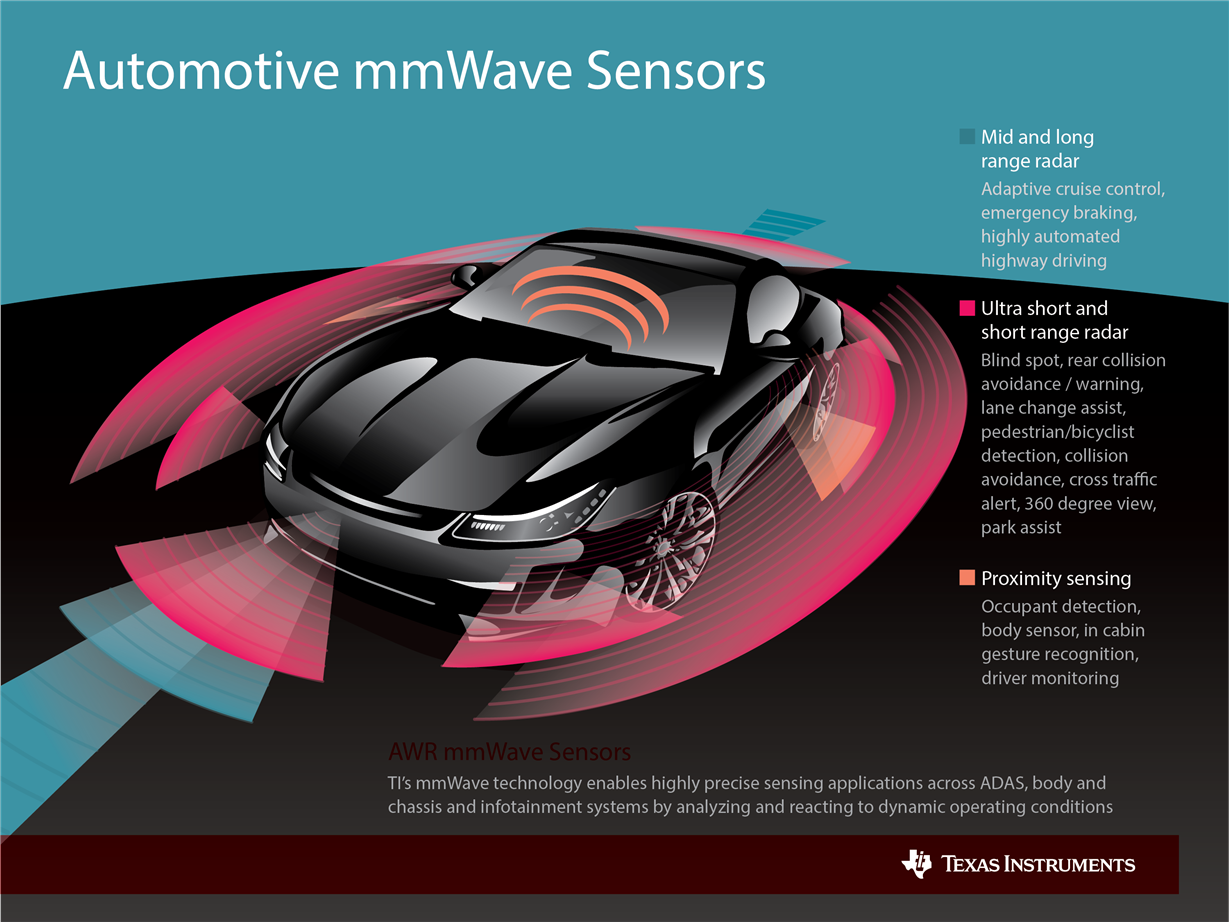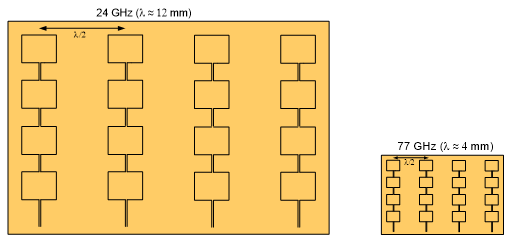SSZT916 october 2017 AWR1243 , AWR1443 , AWR1642
If you’ve driven in a newer model car recently, you’ve probably taken advantage of advanced driver assistance systems like autonomous emergency braking, cross-traffic alerts or lane change assist. But have you ever thought about how your car knows when to stop to avoid a front collision? Or what system keeps drivers from changing lanes when that lane is occupied? Or even when backing out of a parking space, how might a car “know” that another vehicle is speeding down the alley?
Part of the answer to all of these questions is automotive radar. Radar is simply a method of using radio waves to determine the range, angle and relative velocity of objects. In today’s vehicle safety systems, radars are used in conjunction with cameras, ultrasound and other sensors to obtain information about a vehicle’s surroundings. Using high-level processing technology to facilitate the fusion of this sensor data can lead to improved object identification and decision-making, allowing the vehicle to decide, as an example, whether the driver is drifting into the next lane or is deliberately moving over. The need for this information has driven large increases in the number of automobiles built with one or more radar systems.
Customer demand for systems like blind-spot detection (BSD), lane-change assist (LCA) and front/rear cross-traffic alert (F/RCTA), autonomous emergency braking (AEB), and adaptive cruise control (ACC) has driven an increase in radar-sensor production. Many vehicles contain one or more of the radars shown in Figure 1.
 Figure 1 Automotive Radar
Systems
Figure 1 Automotive Radar
SystemsTraditionally, many of these systems used frequencies in the 24GHz band. For automotive, both a narrow band (NB) and an ultra-wide band (UWB) are currently available. The unregulated 24 GHz NB spans 200MHz, from 24.05 GHz to 24.25GHz. The 24GHz UWB spans 5GHz, from 21.65GHz to 26.65GHz.
Due to spectrum regulations and standards developed by the European Telecommunications Standards Institute (ETSI) and Federal Communications Commission (FCC), the use of the UWB band will be phased out by the year 2022 (the “sunset date”) in both Europe and the U.S.
In phasing out the 24GHz UWB, the regulating authorities have opened up frequencies for automotive radar in the 77GHz band. As Figure 2 shows, the bandwidth available from 77-81GHz provides up to 4GHz of sweep bandwidth, which is much larger than the 200MHz available in the 24GHz NB.
 Figure 2 Available Automotive Radar
Bands
Figure 2 Available Automotive Radar
BandsWhy Is Sweep Bandwidth Important?
Today’s radar systems no longer emit a high-energy ping and measure the time it takes to receive a reflection. A frequency-modulated continuous wave (FMCW) radar transmits a “chirp” that is a frequency sweep (ramp) across the bandwidth of the system. Objects in the path of the signal then reflect this chirp back. The difference between the frequency of the chirp coming out of the transmitter and the frequency of the received reflected signal (at any one time) is linearly related to the distance from the transmitter to the object.
Both the resolution and accuracy of this distance measurement are important. The resolution determines how far apart objects need to be before they are distinguishable as two objects. The accuracy is just that: the accuracy of the distance measurement. The error in the distance measurement and the minimum resolvable distance are inversely proportional to the bandwidth of the chirp. Due to the width of available frequencies, a move from 24GHz to 77GHz can achieve 20x better performance in range resolution and accuracy. The range resolution of a 77GHz system can be 4cm versus 75cm for 24GHz radar, allowing better detection of multiple objects that are close together.
Resolution
You can use the differences in phase between the transmitted signal and the signal at the receiver to measure the relative velocity of an object. As the wavelength decreases, the resolution and accuracy of this velocity measurement improves proportionally. Therefore, as sensors move from 24GHz to 77GHz, velocity measurements can improve by 3x.
System Size
If these reasons were not enough for system designers to move to the 77GHz band, there is one more compelling system benefit that occurs with the switch from 24GHz – solution size! Since the wavelength of 77GHz signals are one-third that of a 24GHz system, an antenna pattern for a given field of view and gain is one-third the size in both the X and Y dimensions. In other words, the total area needed for a 77GHz antenna is one-ninth the size of a similar 24GHz antenna. This enables much smaller modules in space-constrained areas of an automobile. In some cases, radar modules can be nearly as small as the cameras common in today’s automotive safety systems. The relative sizes of these antennas are shown in Figure 3.
 Figure 3 Relative Antenna Sizes for 24GHz and 77GHz
Figure 3 Relative Antenna Sizes for 24GHz and 77GHzAt the same time that demand for automotive radar sensors is rising, the sensors themselves are changing. This make sense, as the transition from 24GHz to 77GHz provides better accuracy and better resolution in a smaller package. With this in mind, it is easy to see why automotive radars are moving from 24GHz to 77GHz.
Additional Resources
For more information on solutions for small 77GHz systems, check out some of these resources:
- The white paper, “Moving from legacy 24 GHz to state-of-the-art 77 GHz radar”
- Short-Range Radar (SRR) Reference Design Using AWR1642.
- TI’s ultra short-range radar applications page.
- The white paper, “AWR1642 mmWave radar sensor: 76-81GHz radar-on-chip for short-range radar applications.”
- The white paper, “TI’s smart sensors ideal for automated driving applications”
- The white paper, “The fundamentals of millimeter wave sensors”
Are you an engineering student ready to solve real-world engineering challenges? Check out our newest university contest.
